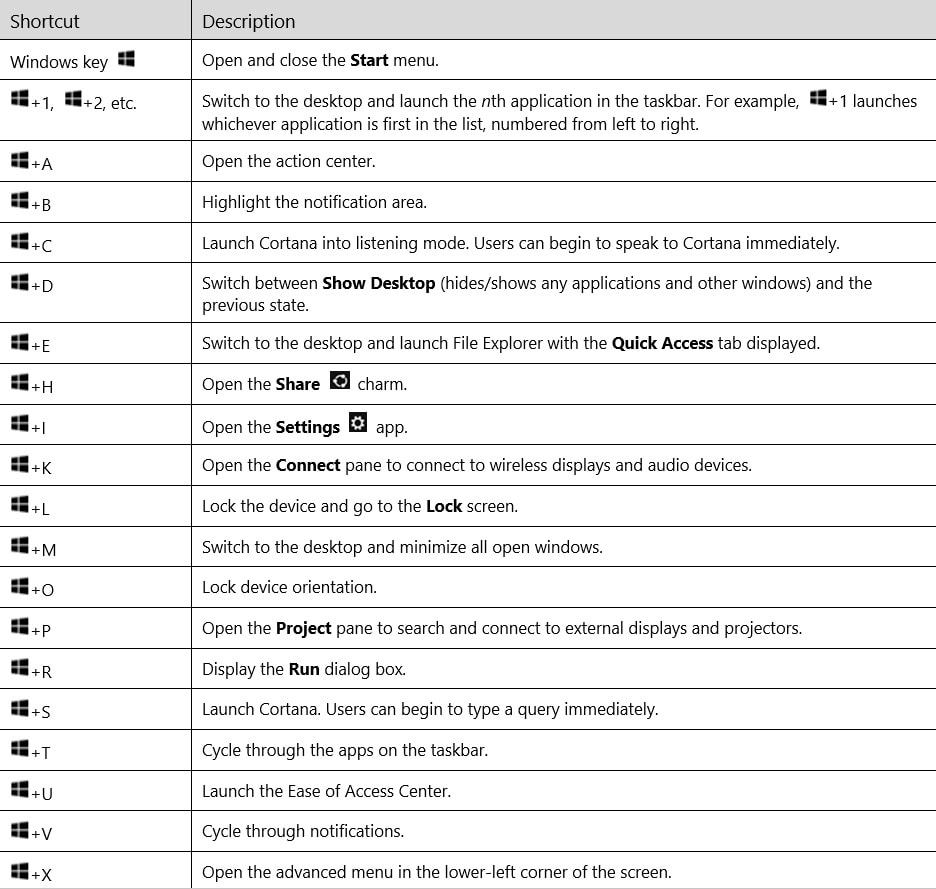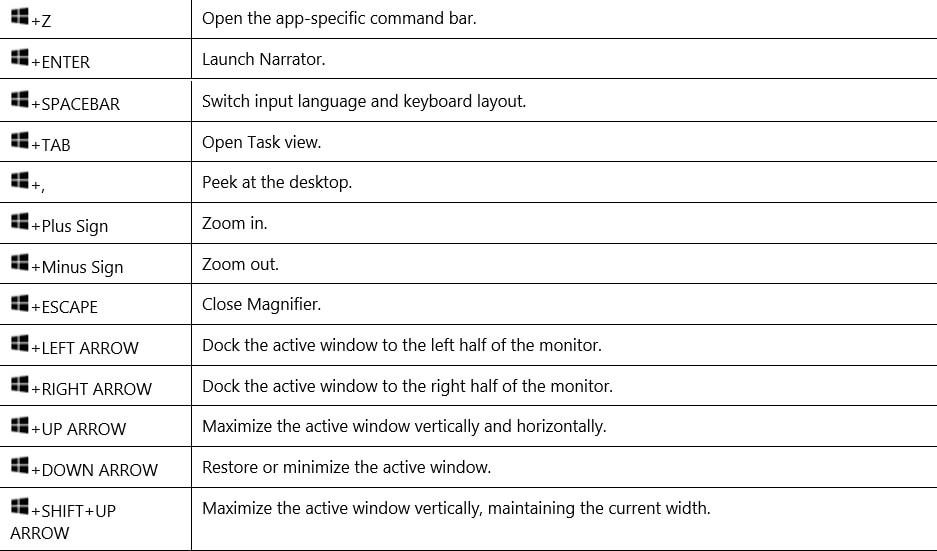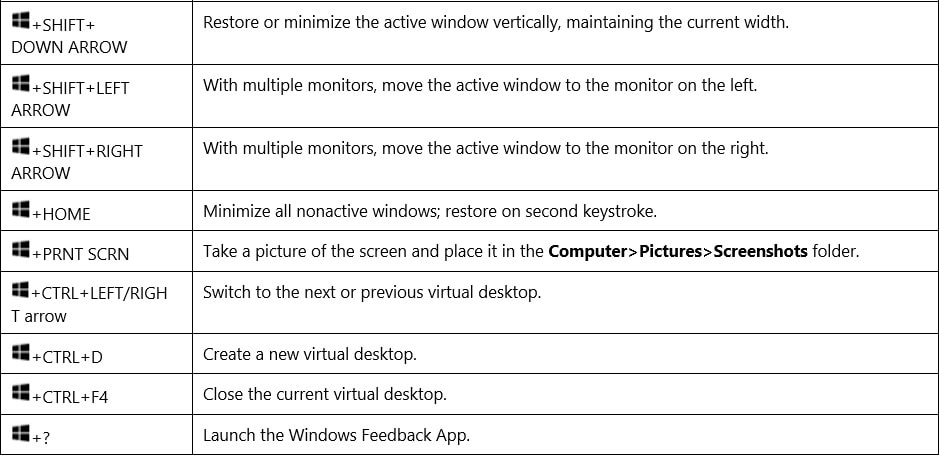window10 官方快捷键 Keyboard shortcuts in Windows
官方:“ Windows徽标键+ Ctrl + Shift + B =将PC从黑屏或黑屏唤醒”
通过与AMD Radeon驱动程序工程师的讨论,它不会重新启动图形驱动程序。它似乎确实丢弃了桌面表面缓冲区并从DWM重新创建分配(在运行良好的系统上,桌面变黑了一秒钟)。
https://support.microsoft.com/en-us/help/12445/windows-keyboard-shortcuts
Learn more about screenshots with Snip & Sketch
If you are trying to take a screenshot or screengrab, see How to take and annotate screenshots on Windows 10.
Windows 10
Keyboard shortcuts are keys or combinations of keys that provide an alternative way to do something that you’d typically do with a mouse. Click an option below, and it'll open to display a table of related shortcuts:
| Press this key | To do this |
|---|---|
| Ctrl + X | Cut the selected item. |
| Ctrl + C (or Ctrl + Insert) | Copy the selected item. |
| Ctrl + V (or Shift + Insert) | Paste the selected item. |
| Ctrl + Z | Undo an action. |
| Alt + Tab | Switch between open apps. |
| Alt + F4 | Close the active item, or exit the active app. |
| Windows logo key | Lock your PC. |
| Windows logo key | Display and hide the desktop. |
| F2 | Rename the selected item. |
| F3 | Search for a file or folder in File Explorer. |
| F4 | Display the address bar list in File Explorer. |
| F5 | Refresh the active window. |
| F6 | Cycle through screen elements in a window or on the desktop. |
| F10 | Activate the Menu bar in the active app. |
| Alt + F8 | Show your password on the sign-in screen. |
| Alt + Esc | Cycle through items in the order in which they were opened. |
| Alt + underlined letter | Perform the command for that letter. |
| Alt + Enter | Display properties for the selected item. |
| Alt + Spacebar | Open the shortcut menu for the active window. |
| Alt + Left arrow | Go back. |
| Alt + Right arrow | Go forward. |
| Alt + Page Up | Move up one screen. |
| Alt + Page Down | Move down one screen. |
| Ctrl + F4 | Close the active document (in apps that are full-screen and let you have multiple documents open at the same time). |
| Ctrl + A | Select all items in a document or window. |
| Ctrl + D (or Delete) | Delete the selected item and move it to the Recycle Bin. |
| Ctrl + R (or F5) | Refresh the active window. |
| Ctrl + Y | Redo an action. |
| Ctrl + Right arrow | Move the cursor to the beginning of the next word. |
| Ctrl + Left arrow | Move the cursor to the beginning of the previous word. |
| Ctrl + Down arrow | Move the cursor to the beginning of the next paragraph. |
| Ctrl + Up arrow | Move the cursor to the beginning of the previous paragraph. |
| Ctrl + Alt + Tab | Use the arrow keys to switch between all open apps. |
| Alt + Shift + arrow keys | When a group or tile is in focus on the Start menu, move it in the direction specified. |
| Ctrl + Shift + arrow keys | When a tile is in focus on the Start menu, move it into another tile to create a folder. |
| Ctrl + arrow keys | Resize the Start menu when it's open. |
| Ctrl + arrow key (to move to an item) + Spacebar | Select multiple individual items in a window or on the desktop. |
| Ctrl + Shift with an arrow key | Select a block of text. |
| Ctrl + Esc | Open Start. |
| Ctrl + Shift + Esc | Open Task Manager. |
| Ctrl + Shift | Switch the keyboard layout when multiple keyboard layouts are available. |
| Ctrl + Spacebar | Turn the Chinese input method editor (IME) on or off. |
| Shift + F10 | Display the shortcut menu for the selected item. |
| Shift with any arrow key | Select more than one item in a window or on the desktop, or select text in a document. |
| Shift + Delete | Delete the selected item without moving it to the Recycle Bin first. |
| Right arrow | Open the next menu to the right, or open a submenu. |
| Left arrow | Open the next menu to the left, or close a submenu. |
| Esc | Stop or leave the current task. |
| PrtScn |
Take a screenshot of your whole screen and copy it to the clipboard. Note
|
| Press this key | To do this |
|---|---|
| Windows logo key | Open or close Start. |
| Windows logo key | Open Action center. |
| Windows logo key | Set focus in the notification area. |
| Windows logo key |
Open Cortana in listening mode.
Notes
|
| Windows logo key | Open the charms menu. |
| Windows logo key | Display and hide the desktop. |
| Windows logo key | Display and hide the date and time on the desktop. |
| Windows logo key | Open File Explorer. |
| Windows logo key | Open Feedback Hub and take a screenshot. |
| Windows logo key | Open Game bar when a game is open. |
| Windows logo key | Start dictation. |
| Windows logo key | Open Settings. |
|
Windows logo key |
Set focus to a Windows tip when one is available. When a Windows tip appears, bring focus to the Tip. Pressing the keyboard shortcuts again to bring focus to the element on the screen to which the Windows tip is anchored. |
| Windows logo key | Open the Connect quick action. |
| Windows logo key | Lock your PC or switch accounts. |
| Windows logo key | Minimize all windows. |
| Windows logo key | Lock device orientation. |
| Windows logo key | Choose a presentation display mode. |
| Windows logo key | Open Quick Assist. |
| Windows logo key | Open the Run dialog box. |
| Windows logo key | Open search. |
| Windows logo key | Take a screenshot of part of your screen. |
| Windows logo key | Cycle through apps on the taskbar. |
| Windows logo key | Open Ease of Access Center. |
| Windows logo key |
Open the clipboard. Note
|
| Windows logo key | Cycle through notifications. |
| Windows logo key | Open the Quick Link menu. |
| Windows logo key | Switch input between Windows Mixed Reality and your desktop. |
| Windows logo key | Show the commands available in an app in full-screen mode. |
| Windows logo key | Open emoji panel. |
| Windows logo key | Temporarily peek at the desktop. |
| Windows logo key | Display the System Properties dialog box. |
| Windows logo key | Search for PCs (if you're on a network). |
| Windows logo key | Restore minimized windows on the desktop. |
| Windows logo key | Open the desktop and start the app pinned to the taskbar in the position indicated by the number. If the app is already running, switch to that app. |
| Windows logo key | Open the desktop and start a new instance of the app pinned to the taskbar in the position indicated by the number. |
| Windows logo key | Open the desktop and switch to the last active window of the app pinned to the taskbar in the position indicated by the number. |
| Windows logo key | Open the desktop and open the Jump List for the app pinned to the taskbar in the position indicated by the number. |
| Windows logo key | Open the desktop and open a new instance of the app located at the given position on the taskbar as an administrator. |
| Windows logo key | Open Task view. |
| Windows logo key | Maximize the window. |
| Windows logo key | Remove current app from screen or minimize the desktop window. |
| Windows logo key | Maximize the app or desktop window to the left side of the screen. |
| Windows logo key | Maximize the app or desktop window to the right side of the screen. |
| Windows logo key | Minimize all except the active desktop window (restores all windows on second stroke). |
| Windows logo key | Stretch the desktop window to the top and bottom of the screen. |
| Windows logo key | Restore/minimize active desktop windows vertically, maintaining width. |
| Windows logo key | Move an app or window in the desktop from one monitor to another. |
| Windows logo key | Switch input language and keyboard layout. |
| Windows logo key | Change to a previously selected input. |
| Windows logo key | Turn on Narrator. |
| Windows logo key | Open Magnifier. |
| Windows logo key | Begin IME reconversion. |
| Windows logo key | Open shoulder taps. |
| Windows logo key | Wake PC from blank or black screen |
| Press this key | To do this |
|---|---|
| Ctrl + C (or Ctrl + Insert) | Copy the selected text. |
| Ctrl + V (or Shift + Insert) | Paste the selected text. |
| Ctrl + M | Enter Mark mode. |
| Alt + selection key | Begin selection in block mode. |
| Arrow keys | Move the cursor in the direction specified. |
| Page up | Move the cursor by one page up. |
| Page down | Move the cursor by one page down. |
| Ctrl + Home (Mark mode) | Move the cursor to the beginning of the buffer. |
| Ctrl + End (Mark mode) | Move the cursor to the end of the buffer. |
| Ctrl + Up arrow | Move up one line in the output history. |
| Ctrl + Down arrow | Move down one line in the output history. |
| Ctrl + Home (History navigation) | If the command line is empty, move the viewport to the top of the buffer. Otherwise, delete all the characters to the left of the cursor in the command line. |
| Ctrl + End (History navigation) | If the command line is empty, move the viewport to the command line. Otherwise, delete all the characters to the right of the cursor in the command line. |
| Press this key | To do this |
|---|---|
| F4 | Display the items in the active list. |
| Ctrl + Tab | Move forward through tabs. |
| Ctrl + Shift + Tab | Move back through tabs. |
| Ctrl + number (number 1–9) | Move to nth tab. |
| Tab | Move forward through options. |
| Shift + Tab | Move back through options. |
| Alt + underlined letter | Perform the command (or select the option) that is used with that letter. |
| Spacebar | Select or clear the check box if the active option is a check box. |
| Backspace | Open a folder one level up if a folder is selected in the Save As or Open dialog box. |
| Arrow keys | Select a button if the active option is a group of option buttons. |
| Press this key | To do this |
|---|---|
| Alt + D | Select the address bar. |
| Ctrl + E | Select the search box. |
| Ctrl + F | Select the search box. |
| Ctrl + N | Open a new window. |
| Ctrl + W | Close the active window. |
| Ctrl + mouse scroll wheel | Change the size and appearance of file and folder icons. |
| Ctrl + Shift + E | Display all folders above the selected folder. |
| Ctrl + Shift + N | Create a new folder. |
| Num Lock + asterisk (*) | Display all subfolders under the selected folder. |
| Num Lock + plus (+) | Display the contents of the selected folder. |
| Num Lock + minus (-) | Collapse the selected folder. |
| Alt + P | Display the preview panel. |
| Alt + Enter | Open the Properties dialog box for the selected item. |
| Alt + Right arrow | View the next folder. |
| Alt + Up arrow | View the folder that the folder was in. |
| Alt + Left arrow | View the previous folder. |
| Backspace | View the previous folder. |
| Right arrow | Display the current selection (if it's collapsed), or select the first subfolder. |
| Left arrow | Collapse the current selection (if it's expanded), or select the folder that the folder was in. |
| End | Display the bottom of the active window. |
| Home | Display the top of the active window. |
| F11 | Maximize or minimize the active window. |
| Press this key | To do this |
|---|---|
| Windows logo key | Open Task view. |
| Windows logo key | Add a virtual desktop. |
| Windows logo key | Switch between virtual desktops you’ve created on the right. |
| Windows logo key | Switch between virtual desktops you’ve created on the left. |
| Windows logo key | Close the virtual desktop you're using. |
| Press this key | To do this |
|---|---|
| Shift + click a taskbar button | Open an app or quickly open another instance of an app. |
| Ctrl + Shift + click a taskbar button | Open an app as an administrator. |
| Shift + right-click a taskbar button | Show the window menu for the app. |
| Shift + right-click a grouped taskbar button | Show the window menu for the group. |
| Ctrl + click a grouped taskbar button | Cycle through the windows of the group. |
Additional keyboard shortcuts
- Keyboard shortcuts in apps
- Windows keyboard shortcuts for accessibility
- Microsoft Surface Hub keyboard shortcuts
- Keyboard shortcuts in Continuum for phones
所有有用的Windows 10键盘快捷键
Windows 10的功能得到了增强,使我们的技术生活更加轻松。微软在启动Windows 10时还添加了许多新的键盘快捷键,这些快捷键将帮助您更轻松地访问新增强功能,例如Cortana,Action Center,Task View和Virtual Desktops。最近,它还推出了备忘单,可以进一步提高您的技术水平。我们将为您提供一些必不可少的键盘快捷键,通过它们可以提高性能,简化操作的速度,并使在Windows系统上学习新知识变得容易。
如果您不熟悉键盘快捷键,那么整个快捷键列表可能会让您不知所措。同样,这些功能中的许多功能也可能在较旧版本的Windows(例如Windows 7 / 8.1)中起作用。为了使您的工作更轻松,我们向您介绍了最重要的快捷方式,这些快捷方式无疑是非常有益的。
另请参阅: 101在Windows 10中运行命令快捷方式



浏览器键盘快捷键。(Microsoft Edge和其他)
1. Ctrl + T –帮助您打开一个新标签页。
2. Ctrl + D –启用当前页面的书签
3. Ctrl + L –突出显示页面的URL。
4. Ctrl + Tab –循环浏览当前打开的选项卡。
Windows 10的必备键盘快捷键
1. Windows键+ A –它使您可以打开操作中心。
2. Windows键+ C –它使您可以在聆听模式下启动Cortana。这对于基于语音的命令特别有用。
3. Windows键+ Tab –使用它可以打开任务视图。
4. Windows键+ I –打开设置应用程序以更改各种设置,例如主题,时间等。
5. Windows键+ S –可用于启动Cortana
6. Windows键+ Ctrl + D –可帮助您创建虚拟桌面。
7. Windows键+ Ctrl + F4 –主要用于关闭当前虚拟桌面
8. Windows键+ Ctrl +左或右箭头–它有助于在虚拟桌面之间切换。
下面给出的快捷方式也适用于较低版本的Windows。
9. Windows键+ X –打开在右键单击开始菜单时显示的列表。
10. Windows键+ E –它有助于启动文件资源管理器。
11. Windows键+ L-用于锁定桌面。
12. Windows键+向左或向右箭头–将当前窗口对齐到屏幕的左侧或右侧
13. Alt + PrtScn –截取当前窗口的屏幕快照并将其复制到剪贴板。
14. Windows Key + PrtScn –拍摄保存在“计算机”>“图片”>“屏幕截图”中的窗口的屏幕截图。
试用上面的快捷方式,暂时降低对鼠标的依赖!



 浙公网安备 33010602011771号
浙公网安备 33010602011771号